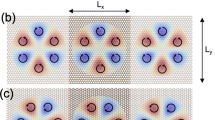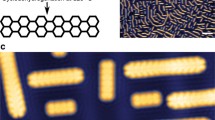The paper focuses on superlattices consisting of two coplanar fragments of one-layer graphene nanoribbons that have different width and are connected at an angle. Classification of such superlattices was carried out; their electronic properties were studied using the tight-binding method. It was demonstrated that in superlattices consisting of two fragments of graphene nanoribbons with armchair edges connected at an angle of 60°, the band gap can be regulated by the number of dimeric carbon atom chains of one of the fragments. In that case one can observe a periodic dependence of the band gap on the number of chains with a characteristic period equal to three dimeric chains. The number of dimeric chains of the second superlattice fragment regulates the average band gap value near which the periodic oscillations occur, as well as the amplitude of those oscillations. Therefore, one can accomplish a sufficiently precise band gap tuning for such structures. Such tuning can find its wide application in the booming carbon nanoelectronics industry when creating generators, amplifiers and sensors in the nanochains.
Similar content being viewed by others
References
A. K. Geim and K. S. Novoselov, Nat. Mater, 6, 183 (2007).
A. H. Castro Neto, N. M. R. Peres, F. Guinea, et al., Rev. Mod. Phys, 81, 109 (2009).
L. A. Chernozatonskii, P. B. Sorokin, A. A. Artukh, Russian Chemical Reviews, 83, Issue 3, 251–279 (2014).
J. Liang, Y. Chen, Y. Xu, et al., ACS Appl. Mater. Interfaces, 2, 3310 (2010).
L. Tapasztó, G. Dobrik, P. Lambin, and L. P. Biró, Nat. Nanotechnol., 3, 397 (2008).
Z. Wei, D. Wang, S. Kim, et al., Science, 328, 1373 (2010).
A. Maffucci and G. Miano, IEEE Trans. Nanotechnol., 12, 817 (2013).
A. Maffucci and G. Miano, Appl. Sci., 4, 305 (2014).
J. Christensen, A. Manjavacas, S. Thongrattanasiri, et al., ACS Nano, 6, 431 (2012).
R. R. Hartmann, N. J. Robinson, and M. E, Portnoi, Phys. Rev. B., 81, 245431 (2010).
X. Zhu, W. Yan, N. A. Mortensen, and S. Xiao, Opt. Express, 21, 3486 (2013).
P. B. Bennett, Z. Pedramrazi, A. Madani, et al., Appl. Phys. Lett., 103, 253114 (2013).
W. S. Hwang, P. Zhao, K. Tahy, et al., APL Mater., 3, 011101 (2015).
J. G. Son, M. Son, K.-J. Moon, et al., Adv. Mater., 25, 4723 (2013).
S. Blankenburg, J. Cai, P. Ruffieux, et al., ACS Nano, 6, 2020 (2012).
J. Cai, C. A. Pignedoli, L. Talirz, et al., Nat. Nanotechnol., 9, 896 (2014).
H. Sevincli, M. Topsakal, and S. Ciraci, Phys. Rev. B., 78, 245402 (2008).
M. Topsakal, H. Sevincli, and S. Ciraci, Appl. Phys. Lett., 92, 173118 (2008).
X. Wu and X. C. Zeng, Nano Res., 1, 40 (2008).
E. Costa Girão, L. Liang, E. Cruz-Silva, et al., Phys. Rev. Lett., 107, 135501 (2011).
J. Cai, P. Ruffieux, R. Jaafar, et al., Nature, 466, 470 (2010).
V. A. Saroka, K. G. Batrakov, L. A. Chernozatonskii, J. Phys. of the Solid State, 56, Issue 10, 2135–2145 (2014).
V. A. Saroka, K. G. Batrakov, V. A. Demin, and L. A. Chernozatonskii, J. Phys. Cond. Matter, 27, 145305 (2015).
C. T. White, J. Li, D. Gunlycke, and J. W. Mintmire, Nano Lett., 7, 825 (2007).
M. Fujita, K. Wakabayashi, K. Nakada, and K. Kusakabe, J. Phys. Soc. Jpn., 65, 1920 (1996).
K. Nakada, M. Fujita, G. Dresselhaus, and M. Dresselhaus, Phys. Rev. B., 54, 17954 (1996).
Y.-W. Son, M. L. Cohen, and S. G. Louie, Phys. Rev. Lett., 97, 216803 (2006).
Author information
Authors and Affiliations
Corresponding author
Additional information
Translated from Izvestiya Vysshikh Uchebnykh Zavedenii, Fizika, No. 5, pp. 27–32, May 2016.
Rights and permissions
About this article
Cite this article
Saroka, V.A., Batrakov, K.G. Zigzag-Shaped Superlattices on the Basis of Graphene Nanoribbons: Structure and Electronic Properties. Russ Phys J 59, 633–639 (2016). https://doi.org/10.1007/s11182-016-0816-6
Received:
Published:
Issue Date:
DOI: https://doi.org/10.1007/s11182-016-0816-6




